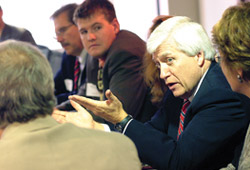
Clay County EDC Director Jim Hampton shares his perspectives on regional growth among colleagues at Ingram’s 4th annual ED Assembly.
Overcoming Resistance
A change in a community's culture, as all economic developers know, invites a certain community resistance. Art Ruiz knows this better than anyone. He joked that he holds the Guinness Book of Records mark for being written about negatively the most consecutive times by the local paper. In Belton's case, the problem has been organized labor's insistence on being included in all TIF-funded projects. This is an issue that he and his colleagues have worked to overcome.
For Pete Fullerton in Platte County, the issue was a tax revolt that unexpectedly cost two popular county commissioners their jobs. Still, as Fullerton noted, "The energy and activity of development in Platte County is too strong for any one or two people to stop."
Charles Jones suggested that the spending of public dollars will always invite response. "When that bill comes due," said Jim Hampton, "you either increase your revenue or cut your expenses. Part of our job is to keep our communities competitive. If you increase taxes, it comes at a cost of being competitive. You must keep a balance."
Jones added that there is a need to be rigorous when looking at the results of a TIF project. The community has to collect data and monitor the project carefully. Indeed there is a need to treat it as a business. "Spending public money," he noted. "can be too easy."
Jean Othic agreed. Most developers understand that when presenting a project they have to present "a winning situation." Here is what one invests. Here is what is returned.
In Topeka, results have had a great way of steamrollering opposition. "When you see new jobs being created for your neighborhood and for your friends," said Doug Kinsinger of the Greater Topeka Chamber of Commerce, "you begin to believe that things can happen."
That much said, Kinsinger and his colleagues have paid a great deal of attention to investing ED money wisely and avoiding projects that don't offer a return on investment. They have also used their money to retain existing business and to grow new business from within. "A little taste of success builds momentum," said Kinsinger. "Our self image is really improving."
Regional Cooperation
"We have always sat around the table and sung Kumbaya," said veteran developer Pete Fullerton on the issue of intra-regional cooperation, "but right now there is a sincerity to it. Folks are understanding that this is a new age. Our urban cores have become competitive. And we are all more successful and stronger for it."
Jim Hampton credited KCADC's "KC One" campaign. "The idea of us all working together helps us all," he noted. Lynn McClure agreed, "I think we are all tapping into the idea of teamwork. The sum of the whole can be exciting. We are all tying into the fact that something great is happening in Kansas City."
"When it comes down to site selection," said Eric Danielson.
"They don't want to see this community or that community. They want to see a region. We have to market Kansas City as a whole."
"When we did our Ingram's feature," added Jim Hampton, "we talked about how a healthy downtown is good for the Northland. I don't recall a time when there is as much on the plate as there is right now. There are a lot of things going on." Lynn McClure also cited the important role that Ingram's plays in "pulling us together and helping us find our commonality."
"People have come to understand," said Jeff Samborski "that maybe their community can't provide everything." This, he believes, has led to an emphasis on the regionalism issue. "We are not competing against each other," he added. "A rising tide lifts all boats."
"We are doing a better job," noted Doug Kinsinger, "of deciding when to complement each other and when to compete." He added, "There is no question that the Kansas City region is being better marketed."
"You had better show you have your act together," said Pete Fullerton, speaking of the increasingly competitive regional competitions, at which, he believes, Kansas City has gotten progressively better. "Sometimes you have to hold your pride," said Don Navinsky, "and ask what can we do together."
Strengthening the Position
As a final question, the participants were asked what the city could do better to strengthen itself in regional competitions. Not surprisingly, the answers were as varied as the participants--more cultural attractions, more funding for schools, better public transportation, and more emphasis on diversity among others.
But Jim Hampton of Clay County may have best defined the area's essential virtue just in speaking of Clay County. "We have high density areas," said Hampton, "but look at the amount of green space we have. Don't we really have an advantage here over a New York City, a Boston, or a Los Angeles? I can't imagine they can offer both."